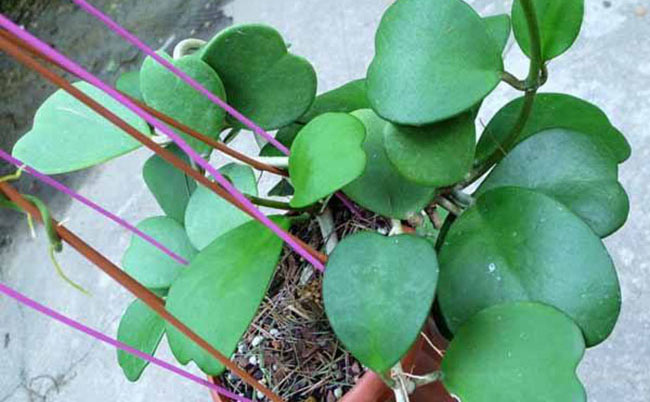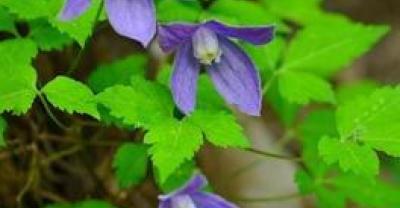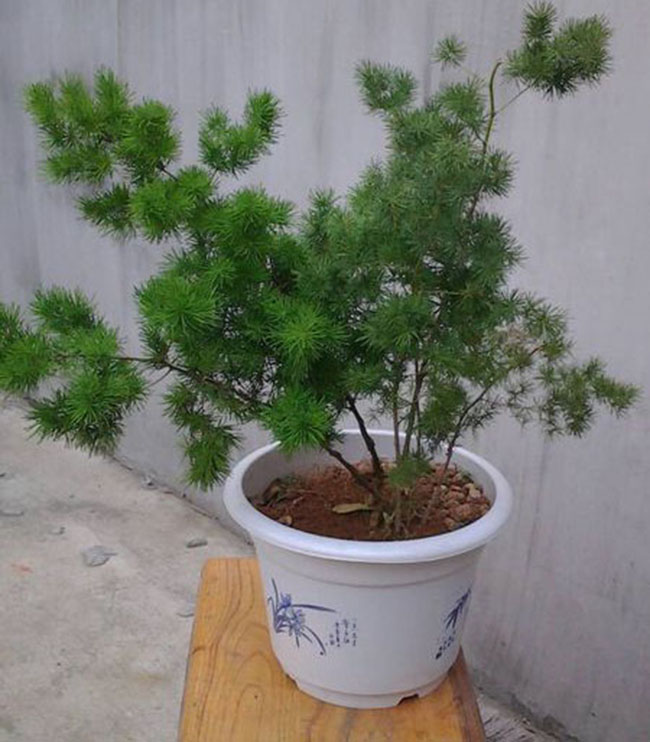Culture methods and matters needing attention of Cymbidium
Morphological characteristics of Cymbidium cordifolia
Character description-A subshrub. Stems and branches climbing to 2 m, yellowish gray. Petiole stout, plump 5 mm, with 3-5 adaxial glands; leaf blade ovate to long ovate, 5-9 × 4-5 cm in size, thinly leathery when dry, adaxial glabrous, abaxial midvein plump, base subcordate, apically pointed to obtuse-rounded; lateral veins 6-8 pairs. Axillary umbels, hemispheric, with 30-50 flowers; peduncle 1-1, 5 cm long. Pedicel 2, 5-3 cm long. Sepals 2, 5 mm in size. Corolla white, radiate, plump, 1 cm in diam.; lobes obtusely triangular, 2, 5 mm in size. Corolla outer horn sharp. Flowering in May.

Growing environment of heart leaf bulb orchid
Also known as Lalan, wax flower, wax spring flower, succulent stem, thick succulent leaves, shaped like a heart. Potted plants should be placed in indirect light or half-day shade, often spraying water to the leaves. The suitable temperature for growth is 18 ℃-28 ℃, and the overwintering temperature is about 5 ℃.
Cultivation and Management of Cymbidium
1. Soil:
Ball orchid is suitable for indoor cultivation. Pot soil can be mixed with garden soil, rotten leaf soil and sand at the ratio of 2:2:1, and the drainage should be good.
two。 Light:
The amount of light will affect the bright degree of orchid flowering. If you want to have a colorful and long flowering period, it is best to put the orchid in the brightest part of the room, but avoid direct sunlight so as not to burn the leaves. Pot plants should be placed in the sun to avoid direct sunlight, indoor can be placed not far from the south window, can keep the leaves green and bright, flowering well. In summer, you need to move to the shade to prevent the strong light from shining directly, otherwise the leaf color will easily turn yellow. If you put it in the lack of light for a long time, the color of the leaves will become lighter, and the flowers will be less and less colorful. Wire can be used as a circle, twining the branches around them, allowing them to climb and grow, which is more conducive to daylighting. The position of the pot plant can not be moved after budding, and the flower ball is always facing the light.
3, temperature:
The sex is warm and humid, and the suitable temperature for fertility is 18-28 ℃. After the middle of October, the temperature should be 10-14 ℃, and the lowest overwintering temperature should be 7 ℃. If it is less than 5 ℃, it is vulnerable to cold injury, causing defoliation and even the death of the whole plant.
4, watering:
In the growing season of fertilizer and water, in addition to watering to see dry and wet, but also often need to spray water on the leaf surface. Summer watering should be adequate, at the same time, attention should be paid to increasing air humidity to facilitate robust growth. In the peak growing season, the fertilizer and water of thin cake combined with nitrogen and phosphorus were applied once or twice a month.
Propagation method of Cymbidium sinensis
This kind of ball orchid can be propagated by cutting or striping. Cuttings must pay attention to, the incision should be flat, if there are conditions, you can apply an appropriate amount of rooting agent. If you choose this method, it is also important to keep the temperature at 20-25 ℃. This time is a little longer, about 2 months. After the root comes out, you only need to observe for another 2 weeks, and when there is no problem with the root development, you can transplant and maintain it normally.
Propagation time of Cymbidium sinensis
This kind of plant can basically reproduce before the end of spring, because this is a good time for them to take root, and their stems and leaves can grow well, and it is not good for them to take root if it is too hot or too cold.
Maintenance of Cymbidium after propagation
After transplanting, you can't relax easily, and you need to take good care of it for a period of time. When it comes to the height of summer, do not think that this kind of flower is very short of water, so as to speed up the frequency of watering. In fact, it is precisely necessary to reduce watering in summer, especially when the sun is strongest around 2 o'clock, try to do it in the evening.
Points for attention of Cymbidium:
1. The ball orchid should be dry and poured thoroughly.
2. Don't water too much in winter.
3. The temperature should be kept above 10 degrees. Bulbous orchids grow fast when the temperature is high, but not when the temperature is low.
4. Do not bask in the sun. If you bask in the sun, there will be spots on the leaf surface, which will affect the viewing. Place it in a bright light, not in the sun. The rest of the planting requirements are the same as the general ball orchid.
How to cultivate Cymbidium angustifolia Culture method
How to cultivate Cymbidium sinensis? Heart leaf ball orchid, also known as Cymbidium, wax flower, wax spring flower, fleshy stem, thick succulent leaves, shaped like a heart, pot planting must be placed in indirect light or half-day shade, the suitable temperature for growth is 18 ℃-28 ℃. The following editor will introduce the cultivation techniques and culture methods of Cymbidium in detail.
Introduction of Cymbidium caryophyllum
Ball orchid originally belongs to Luomaceae, milkweed subfamily, like yin and dampness, shaped like a heart. It has a more popular name "Valentine's ball orchid". If there is sunshine in spring and autumn, the soil fertilizer should not be too heavy, but to keep the soil soft, you can spread some moss on top of the flowerpot in order to moisturize, the summer sun exposure time should not be too long, the rotten leaves should be cut off in time, if the rotten root is serious, the planting soil should be changed, and the flowerpot should be replaced or disinfected before planting, the new soil should be kept dry and should not be too wet. Wait for new buds to continue watering, it is best not to water during the replacement, use a sprayer to spray the blade surface, it is best to place in a sunny and ventilated place, the best place for sunlight is direct sunlight in the morning or half of the afternoon.
Also known as Lalan, wax flower, wax spring flower, succulent stem, thick succulent leaves, shaped like a heart. Potted plants should be placed in indirect light or half-day shade, often spraying water to the leaves. The suitable temperature for growth is 18 ℃-28 ℃, and the overwintering temperature is about 5 ℃.
1. Morphological characteristics
Character description-A subshrub. Stems and branches climbing to 2 m, yellowish gray. Petiole stout, plump 5 mm, with 3-5 adaxial glands; leaf blade ovate to long ovate, 5-9 × 4-5 cm in size, thinly leathery when dry, adaxial glabrous, abaxial midvein plump, base subcordate, apically pointed to obtuse-rounded; lateral veins 6-8 pairs. Axillary umbels, hemispheric, with 30-50 flowers; peduncle 1-1, 5 cm long. Pedicel 2, 5-3 cm long. Sepals 2, 5 mm in size. Corolla white, radiate, plump, 1 cm in diam.; lobes obtusely triangular, 2, 5 mm in size. Corolla outer horn sharp. Flowering in May.
2. Ecological habits
The sex is warm and humid, and the suitable temperature for fertility is 18-28 ℃. After the middle of October, the temperature should be 10-14 ℃, and the lowest overwintering temperature should be 7 ℃. If it is less than 5 ℃, it is vulnerable to cold injury, causing defoliation and even the death of the whole plant.
3. Distribution area
Distribution: born in low pine forest; produced in Guangxi.
IV. Mode of reproduction
The method of cutting or striping is used for propagation, and it is easy to take root. The soil temperature should be kept at 20-25 ℃ when cutting. After about 8 or 10 weeks of culture, the roots will grow, and after two weeks, the roots can be transplanted. High branch crimping can be carried out in spring.
How to cultivate Cymbidium
I. planting management methods
We usually think of Cymbidium as succulent. It is true that many species of this genus are fleshy, but most of them are not really succulent. Cymbidium is also often regarded as a vine, of course, there are many species of climbing trend is very small or none at all. Enthusiasts collect Cymbidium plants from different starting points and cultivation methods, some like twining vines, some like woody tufted shrubs, some like potted plants, some like to make them epiphytic, and some plant them in pots at the beginning. as a result, what was entangled later became clinging growth, and finally they didn't even want their original roots. Some species cling to the supports by winding and rooting at the same time, but some species grow completely upright into small shrubs. Some species look like small shrubs at first, and then begin to stick out climbing vines when they grow to a few feet high. Some species are woody, some are soft and succulent, some have woody stems and succulent leaves, while others have slender stems and leaves as thin as paper.
II. Cultivation and management
Ball orchid is suitable for indoor cultivation. Pot soil can be mixed with garden soil, rotten leaf soil and sand at the ratio of 2:2:1, and the drainage should be good.
The amount of light will affect the bright degree of ball orchid flowering, if you want to have a colorful and long flowering period, it is best to put the ball orchid in the brightest part of the room, but to avoid direct sunlight so as not to burn the leaves. Pot plants should be placed in the sun to avoid direct sunlight, indoor can be placed not far from the south window, can keep the leaves green and bright, flowering well. In summer, you need to move to the shade to prevent the strong light from shining directly, otherwise the leaf color will easily turn yellow. If you put it in the lack of light for a long time, the color of the leaves will become lighter, and the flowers will be less and less colorful. Wire can be used as a circle, twining the branches around them, allowing them to climb and grow, which is more conducive to daylighting. The position of the pot plant can not be moved after budding, and the flower ball is always facing the light.
Culture methods and matters needing attention of Cymbidium sinensis
I. Culture methods
It is best to put the ball orchid in the brightest part of the room, but avoid direct sunlight so as not to burn the leaves. Pot plants should be placed in the sun to avoid direct sunlight, indoor can be placed not far from the south window, can keep the leaves green and bright, flowering well. In summer, you need to move to the shade to prevent the strong light from shining directly, otherwise the leaf color will easily turn yellow. If you put it in the lack of light for a long time, the color of the leaves will become lighter, and the flowers will be less and less colorful. Wire can be used as a circle, twining the branches around them, allowing them to climb and grow, which is more conducive to daylighting. The position of the pot plant can not be moved after budding, and the flower ball is always facing the light.
The sex is warm and humid, and the suitable temperature for fertility is 18-28 ℃. After the middle of October, the temperature should be 10-14 ℃, and the lowest overwintering temperature should be 7 ℃. If it is less than 5 ℃, it is vulnerable to cold injury, causing defoliation and even the death of the whole plant.
2. matters needing attention in the culture of Cymbidium.
Flower soil has good water permeability, weak acid soil properties, not in the lowest temperature of 5 degrees Celsius for a long time, no stagnant water at the bottom of the basin, flower soil water content of not less than 15%, no exposure shade rate of 75%, thin fertilizer can ensure the healthy growth of ball orchid.
The propagation of orchid is best selected in spring and autumn, pruning must choose vigorous branches, cutting medium can choose water moss, coconut Kang, sawdust and so on.
Culture methods and matters needing attention of Cymbidium
Soil requirements of Cymbidium sinensis
Ball orchid is suitable for indoor cultivation. Pot soil can be mixed with garden soil, rotten leaf soil and sand at the ratio of 2:2:1, and the drainage should be good.
Lighting requirements of Cymbidium sinensis
The amount of light will affect the bright degree of ball orchid flowering, if you want to have a colorful and long flowering period, it is best to put the ball orchid in the brightest part of the room, but to avoid direct sunlight so as not to burn the leaves. Pot plants should be placed in the sun to avoid direct sunlight, indoor can be placed not far from the south window, can keep the leaves green and bright, flowering well. In summer, you need to move to the shade to prevent the strong light from shining directly, otherwise the leaf color will easily turn yellow. If you put it in the lack of light for a long time, the color of the leaves will become lighter, and the flowers will be less and less colorful. Wire can be used as a circle, twining the branches around them, allowing them to climb and grow, which is more conducive to daylighting. The position of the pot plant can not be moved after budding, and the flower ball is always facing the light.
Temperature requirement of heart leaf bulb orchid
The sex is warm and humid, and the suitable temperature for fertility is 18-28 ℃. After the middle of October, the temperature should be 10-14 ℃, and the lowest overwintering temperature should be 7 ℃. If it is less than 5 ℃, it is vulnerable to cold injury, causing defoliation and even the death of the whole plant.
Propagation methods of Cymbidium sinensis
The method of cutting or striping is used for propagation, and it is easy to take root. Generally speaking, cuttage is carried out in late spring; a section of stem tip of about 10 cm is cut, and the cut is stained with rooting agent and then inserted into the soil for cutting. buds can also be used. When cutting, the soil temperature should be kept at 20 ℃ 25 min. After about 8 or 10 weeks of culture, the roots will grow, and after two weeks, the roots can be transplanted. High branch crimping can be carried out in spring.
- Prev

Planting method and appreciation of bonsai of real cypress
True cypress likes light, slightly shade tolerance, strong cold resistance, but also resistant to barren, can be born in rock crevices; loose requirements for soil, neutral soil, calcareous soil can adapt. But...
- Next

Culture methods and matters needing attention of Penglai pine
Penglai Penglai pine alias Hydrangea pine, water pine, pine leaf asparagus, pine leaf asparagus, pine bamboo grass, etc., is a perennial shrub-like herb belonging to the asparagus family. The plant height of Penglai is 30-150cm, the stem is erect or slightly scattered, and the Lignification is shrub-like. With white hypertrophic fleshy roots. The plant has a large number of tufted stems
Related
- Fuxing push coffee new agricultural production and marketing class: lack of small-scale processing plants
- Jujube rice field leisure farm deep ploughing Yilan for five years to create a space for organic food and play
- Nongyu Farm-A trial of organic papaya for brave women with advanced technology
- Four points for attention in the prevention and control of diseases and insect pests of edible fungi
- How to add nutrient solution to Edible Fungi
- Is there any good way to control edible fungus mites?
- Open Inoculation Technology of Edible Fungi
- Is there any clever way to use fertilizer for edible fungus in winter?
- What agents are used to kill the pathogens of edible fungi in the mushroom shed?
- Rapid drying of Edible Fungi

